Corporate Culture and Strategy: An Analysis of Organizational Culture
VerifiedAdded on 2021/06/16
|10
|1702
|71
Report
AI Summary
This report provides an in-depth analysis of corporate culture and its strategic implications within organizations. It begins by defining corporate culture and its importance, emphasizing the need for proper integration with organizational strategy to boost performance. The report then explores various types of corporate cultures, including hierarchy, adhocracy, clan, and market cultures, providing examples of how these cultures manifest in real-world business scenarios. A case study of Woolworths, an Australian retail company, demonstrates the successful integration of different organizational cultures to achieve strategic goals. The report further defines organizational culture and highlights the reasons why managers should prioritize it. It also examines the Commonwealth Bank as an example of a company that has implemented a strong organizational culture. The report concludes by underscoring the importance of aligning corporate culture with strategy for improved performance and productivity, emphasizing that organizational culture is a critical factor for success.
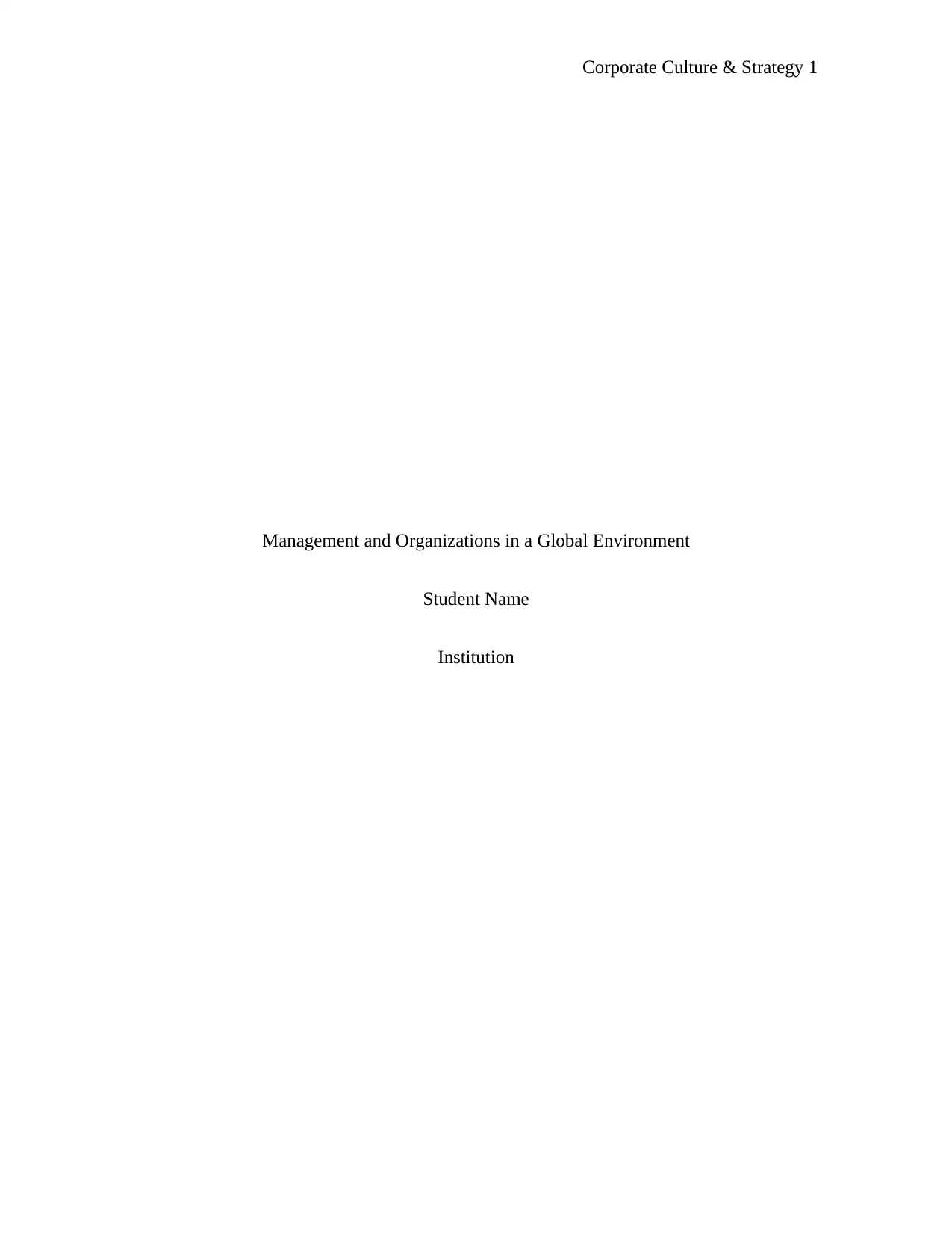
Corporate Culture & Strategy 1
Management and Organizations in a Global Environment
Student Name
Institution
Management and Organizations in a Global Environment
Student Name
Institution
Paraphrase This Document
Need a fresh take? Get an instant paraphrase of this document with our AI Paraphraser

Corporate Culture & Strategy 2
Executive Summary
Culture is the characteristic and understanding of other peoples’ social habits, language, arts, and
religious backgrounds. Corporate culture represents the professional values adopted by a
company to establish a proper employee, clients, and partner’s relationship in the business
(Farndale, Scullion, and Sparrow, 2010, p. 165). The assignment presents two weeks 3 activities.
Activity one will major in corporate culture and strategy while activity 2 will define culture.
Corporate culture and strategy activity analysis will discuss culture clashes in the event corporate
culture fights corporate strategy and the cost it exposes an organization to. Activity 2 will explain
the meaning of organizational culture and the reasons why managers should care about
organizational cultures.
Executive Summary
Culture is the characteristic and understanding of other peoples’ social habits, language, arts, and
religious backgrounds. Corporate culture represents the professional values adopted by a
company to establish a proper employee, clients, and partner’s relationship in the business
(Farndale, Scullion, and Sparrow, 2010, p. 165). The assignment presents two weeks 3 activities.
Activity one will major in corporate culture and strategy while activity 2 will define culture.
Corporate culture and strategy activity analysis will discuss culture clashes in the event corporate
culture fights corporate strategy and the cost it exposes an organization to. Activity 2 will explain
the meaning of organizational culture and the reasons why managers should care about
organizational cultures.
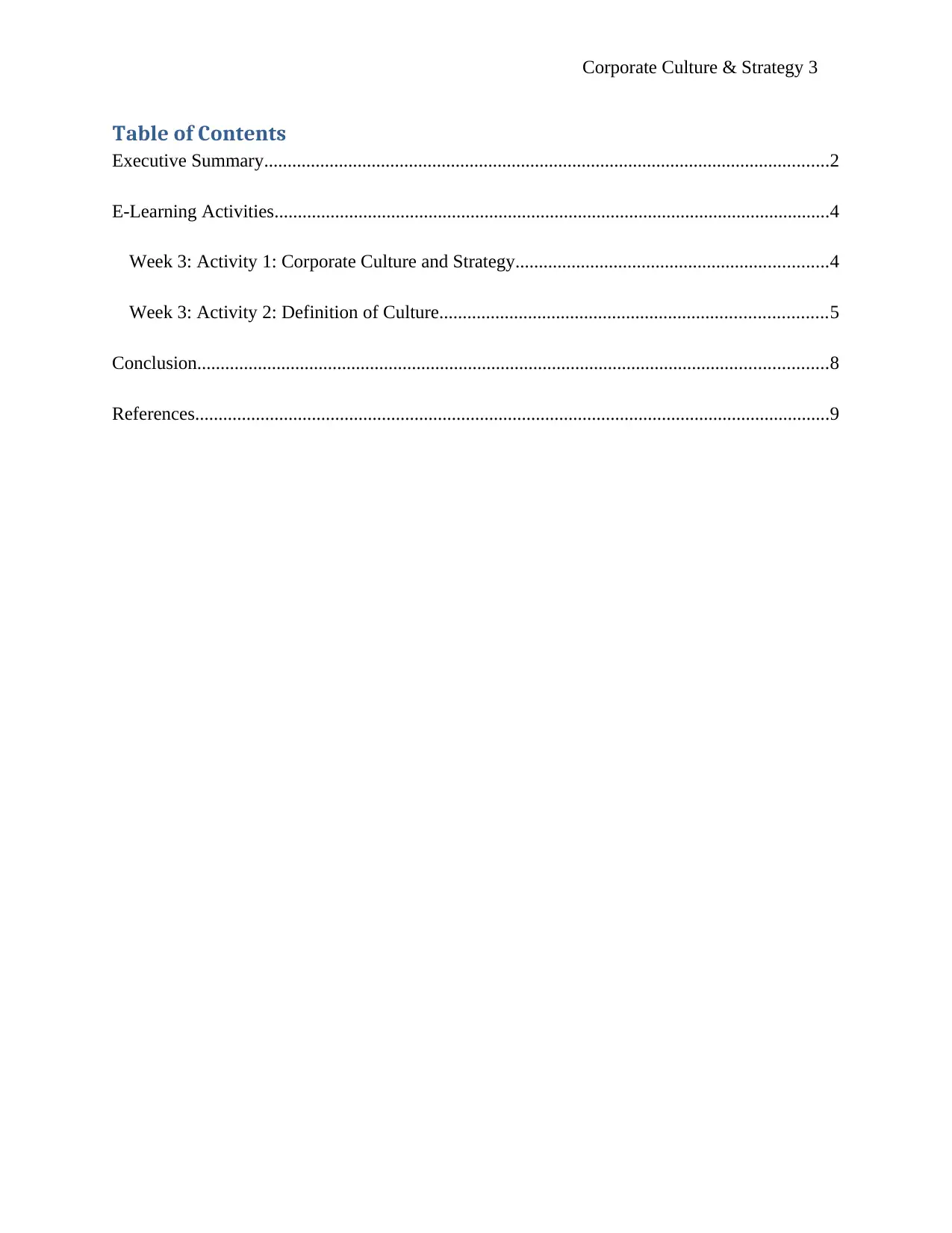
Corporate Culture & Strategy 3
Table of Contents
Executive Summary.........................................................................................................................2
E-Learning Activities.......................................................................................................................4
Week 3: Activity 1: Corporate Culture and Strategy...................................................................4
Week 3: Activity 2: Definition of Culture...................................................................................5
Conclusion.......................................................................................................................................8
References........................................................................................................................................9
Table of Contents
Executive Summary.........................................................................................................................2
E-Learning Activities.......................................................................................................................4
Week 3: Activity 1: Corporate Culture and Strategy...................................................................4
Week 3: Activity 2: Definition of Culture...................................................................................5
Conclusion.......................................................................................................................................8
References........................................................................................................................................9
⊘ This is a preview!⊘
Do you want full access?
Subscribe today to unlock all pages.

Trusted by 1+ million students worldwide
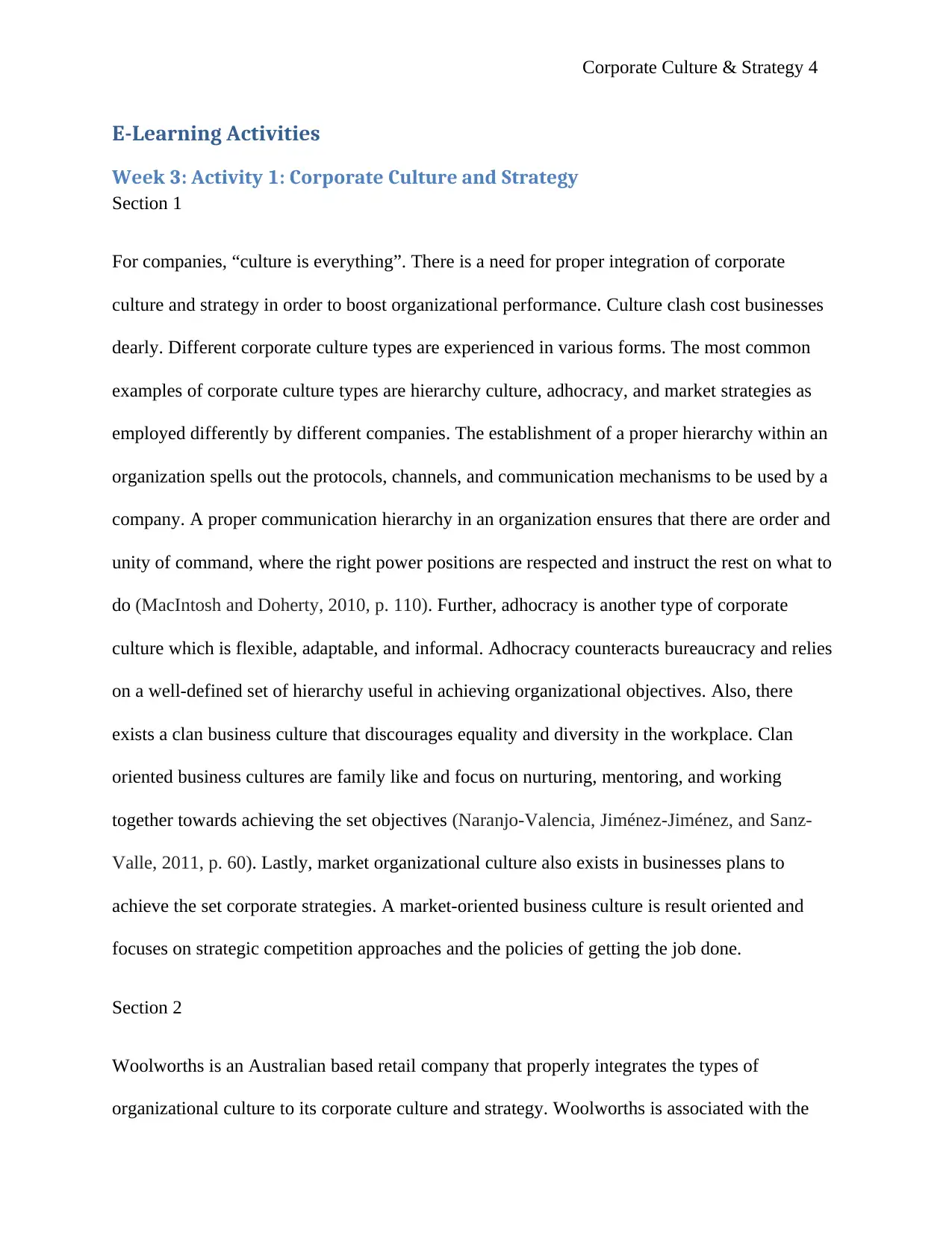
Corporate Culture & Strategy 4
E-Learning Activities
Week 3: Activity 1: Corporate Culture and Strategy
Section 1
For companies, “culture is everything”. There is a need for proper integration of corporate
culture and strategy in order to boost organizational performance. Culture clash cost businesses
dearly. Different corporate culture types are experienced in various forms. The most common
examples of corporate culture types are hierarchy culture, adhocracy, and market strategies as
employed differently by different companies. The establishment of a proper hierarchy within an
organization spells out the protocols, channels, and communication mechanisms to be used by a
company. A proper communication hierarchy in an organization ensures that there are order and
unity of command, where the right power positions are respected and instruct the rest on what to
do (MacIntosh and Doherty, 2010, p. 110). Further, adhocracy is another type of corporate
culture which is flexible, adaptable, and informal. Adhocracy counteracts bureaucracy and relies
on a well-defined set of hierarchy useful in achieving organizational objectives. Also, there
exists a clan business culture that discourages equality and diversity in the workplace. Clan
oriented business cultures are family like and focus on nurturing, mentoring, and working
together towards achieving the set objectives (Naranjo-Valencia, Jiménez-Jiménez, and Sanz-
Valle, 2011, p. 60). Lastly, market organizational culture also exists in businesses plans to
achieve the set corporate strategies. A market-oriented business culture is result oriented and
focuses on strategic competition approaches and the policies of getting the job done.
Section 2
Woolworths is an Australian based retail company that properly integrates the types of
organizational culture to its corporate culture and strategy. Woolworths is associated with the
E-Learning Activities
Week 3: Activity 1: Corporate Culture and Strategy
Section 1
For companies, “culture is everything”. There is a need for proper integration of corporate
culture and strategy in order to boost organizational performance. Culture clash cost businesses
dearly. Different corporate culture types are experienced in various forms. The most common
examples of corporate culture types are hierarchy culture, adhocracy, and market strategies as
employed differently by different companies. The establishment of a proper hierarchy within an
organization spells out the protocols, channels, and communication mechanisms to be used by a
company. A proper communication hierarchy in an organization ensures that there are order and
unity of command, where the right power positions are respected and instruct the rest on what to
do (MacIntosh and Doherty, 2010, p. 110). Further, adhocracy is another type of corporate
culture which is flexible, adaptable, and informal. Adhocracy counteracts bureaucracy and relies
on a well-defined set of hierarchy useful in achieving organizational objectives. Also, there
exists a clan business culture that discourages equality and diversity in the workplace. Clan
oriented business cultures are family like and focus on nurturing, mentoring, and working
together towards achieving the set objectives (Naranjo-Valencia, Jiménez-Jiménez, and Sanz-
Valle, 2011, p. 60). Lastly, market organizational culture also exists in businesses plans to
achieve the set corporate strategies. A market-oriented business culture is result oriented and
focuses on strategic competition approaches and the policies of getting the job done.
Section 2
Woolworths is an Australian based retail company that properly integrates the types of
organizational culture to its corporate culture and strategy. Woolworths is associated with the
Paraphrase This Document
Need a fresh take? Get an instant paraphrase of this document with our AI Paraphraser
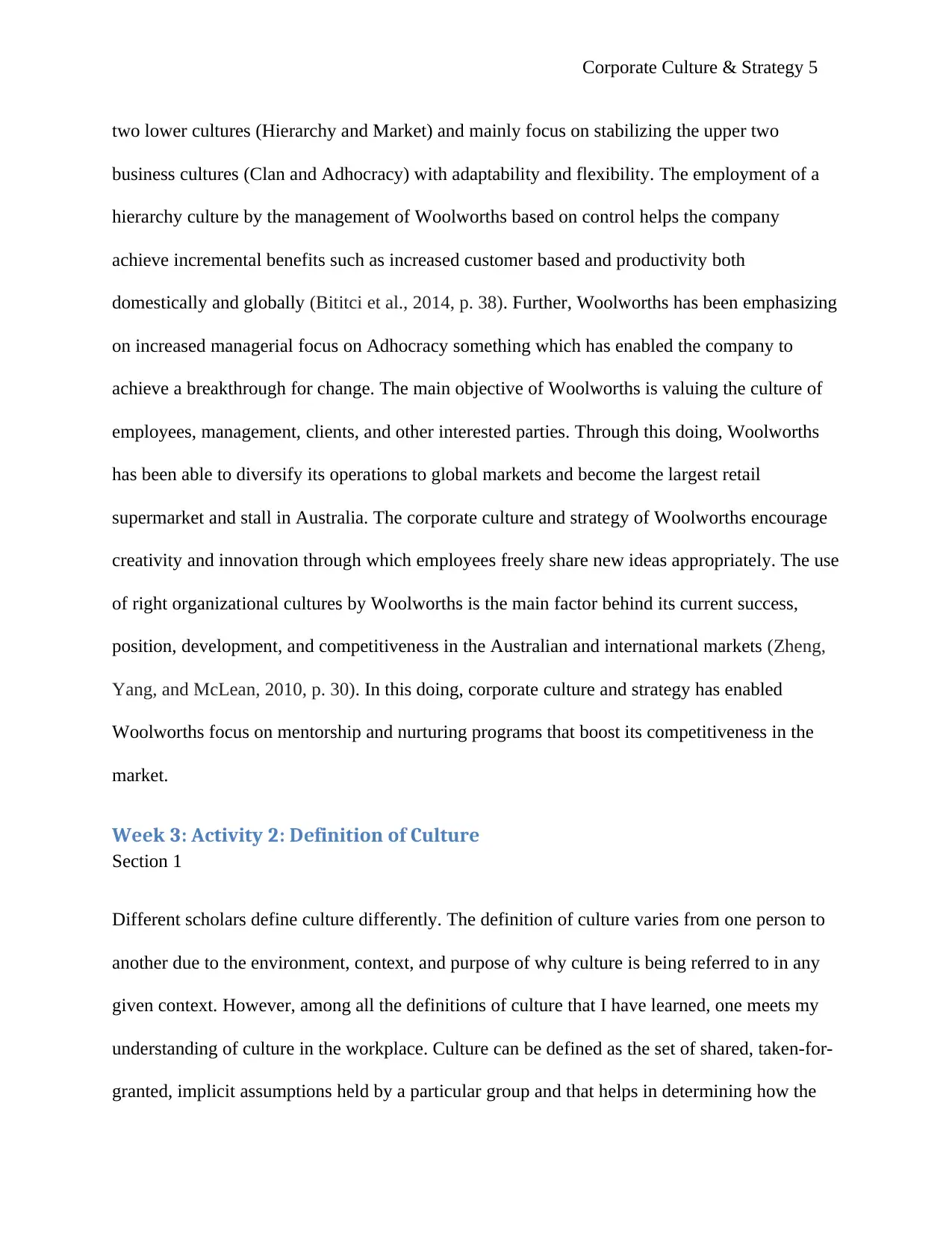
Corporate Culture & Strategy 5
two lower cultures (Hierarchy and Market) and mainly focus on stabilizing the upper two
business cultures (Clan and Adhocracy) with adaptability and flexibility. The employment of a
hierarchy culture by the management of Woolworths based on control helps the company
achieve incremental benefits such as increased customer based and productivity both
domestically and globally (Bititci et al., 2014, p. 38). Further, Woolworths has been emphasizing
on increased managerial focus on Adhocracy something which has enabled the company to
achieve a breakthrough for change. The main objective of Woolworths is valuing the culture of
employees, management, clients, and other interested parties. Through this doing, Woolworths
has been able to diversify its operations to global markets and become the largest retail
supermarket and stall in Australia. The corporate culture and strategy of Woolworths encourage
creativity and innovation through which employees freely share new ideas appropriately. The use
of right organizational cultures by Woolworths is the main factor behind its current success,
position, development, and competitiveness in the Australian and international markets (Zheng,
Yang, and McLean, 2010, p. 30). In this doing, corporate culture and strategy has enabled
Woolworths focus on mentorship and nurturing programs that boost its competitiveness in the
market.
Week 3: Activity 2: Definition of Culture
Section 1
Different scholars define culture differently. The definition of culture varies from one person to
another due to the environment, context, and purpose of why culture is being referred to in any
given context. However, among all the definitions of culture that I have learned, one meets my
understanding of culture in the workplace. Culture can be defined as the set of shared, taken-for-
granted, implicit assumptions held by a particular group and that helps in determining how the
two lower cultures (Hierarchy and Market) and mainly focus on stabilizing the upper two
business cultures (Clan and Adhocracy) with adaptability and flexibility. The employment of a
hierarchy culture by the management of Woolworths based on control helps the company
achieve incremental benefits such as increased customer based and productivity both
domestically and globally (Bititci et al., 2014, p. 38). Further, Woolworths has been emphasizing
on increased managerial focus on Adhocracy something which has enabled the company to
achieve a breakthrough for change. The main objective of Woolworths is valuing the culture of
employees, management, clients, and other interested parties. Through this doing, Woolworths
has been able to diversify its operations to global markets and become the largest retail
supermarket and stall in Australia. The corporate culture and strategy of Woolworths encourage
creativity and innovation through which employees freely share new ideas appropriately. The use
of right organizational cultures by Woolworths is the main factor behind its current success,
position, development, and competitiveness in the Australian and international markets (Zheng,
Yang, and McLean, 2010, p. 30). In this doing, corporate culture and strategy has enabled
Woolworths focus on mentorship and nurturing programs that boost its competitiveness in the
market.
Week 3: Activity 2: Definition of Culture
Section 1
Different scholars define culture differently. The definition of culture varies from one person to
another due to the environment, context, and purpose of why culture is being referred to in any
given context. However, among all the definitions of culture that I have learned, one meets my
understanding of culture in the workplace. Culture can be defined as the set of shared, taken-for-
granted, implicit assumptions held by a particular group and that helps in determining how the
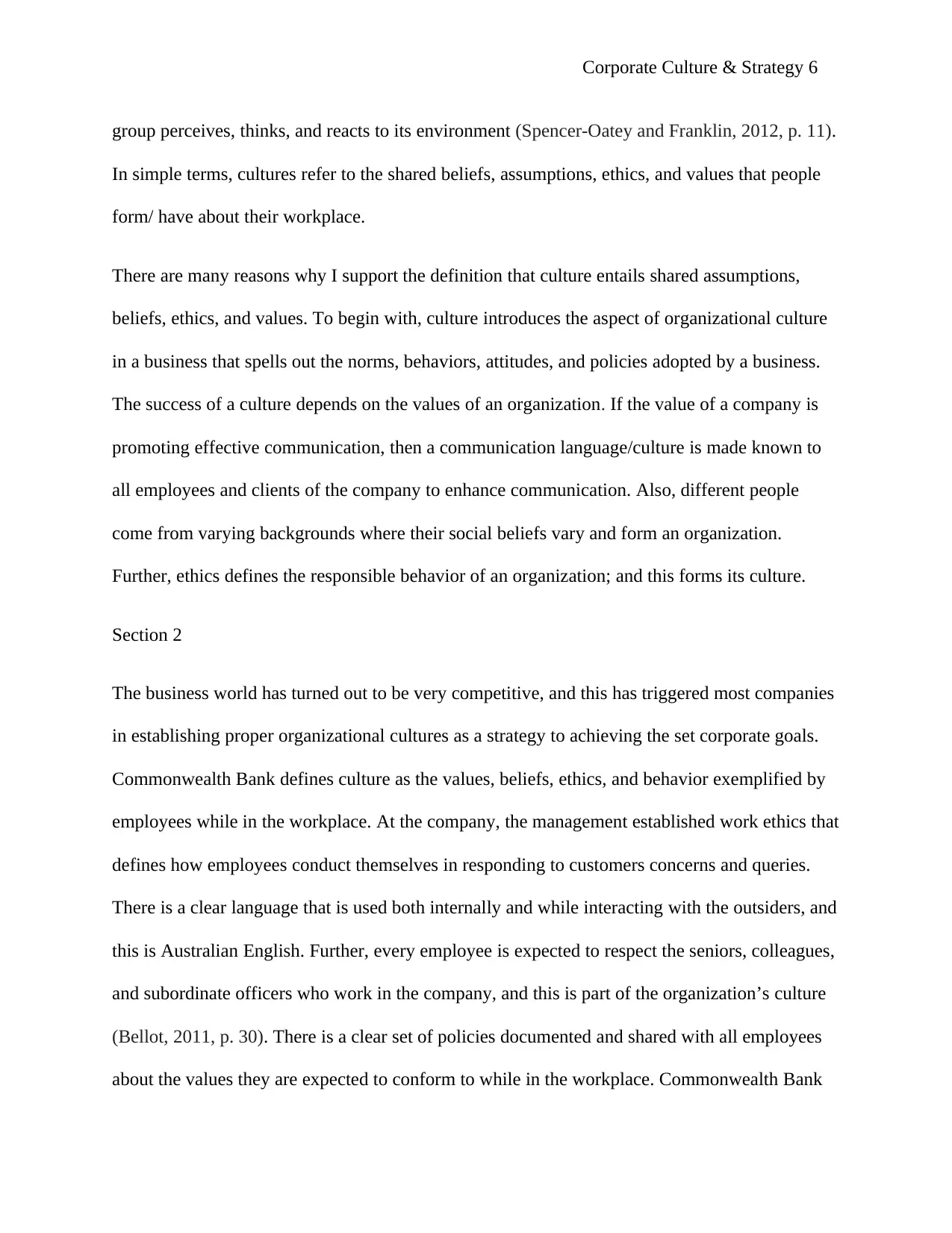
Corporate Culture & Strategy 6
group perceives, thinks, and reacts to its environment (Spencer-Oatey and Franklin, 2012, p. 11).
In simple terms, cultures refer to the shared beliefs, assumptions, ethics, and values that people
form/ have about their workplace.
There are many reasons why I support the definition that culture entails shared assumptions,
beliefs, ethics, and values. To begin with, culture introduces the aspect of organizational culture
in a business that spells out the norms, behaviors, attitudes, and policies adopted by a business.
The success of a culture depends on the values of an organization. If the value of a company is
promoting effective communication, then a communication language/culture is made known to
all employees and clients of the company to enhance communication. Also, different people
come from varying backgrounds where their social beliefs vary and form an organization.
Further, ethics defines the responsible behavior of an organization; and this forms its culture.
Section 2
The business world has turned out to be very competitive, and this has triggered most companies
in establishing proper organizational cultures as a strategy to achieving the set corporate goals.
Commonwealth Bank defines culture as the values, beliefs, ethics, and behavior exemplified by
employees while in the workplace. At the company, the management established work ethics that
defines how employees conduct themselves in responding to customers concerns and queries.
There is a clear language that is used both internally and while interacting with the outsiders, and
this is Australian English. Further, every employee is expected to respect the seniors, colleagues,
and subordinate officers who work in the company, and this is part of the organization’s culture
(Bellot, 2011, p. 30). There is a clear set of policies documented and shared with all employees
about the values they are expected to conform to while in the workplace. Commonwealth Bank
group perceives, thinks, and reacts to its environment (Spencer-Oatey and Franklin, 2012, p. 11).
In simple terms, cultures refer to the shared beliefs, assumptions, ethics, and values that people
form/ have about their workplace.
There are many reasons why I support the definition that culture entails shared assumptions,
beliefs, ethics, and values. To begin with, culture introduces the aspect of organizational culture
in a business that spells out the norms, behaviors, attitudes, and policies adopted by a business.
The success of a culture depends on the values of an organization. If the value of a company is
promoting effective communication, then a communication language/culture is made known to
all employees and clients of the company to enhance communication. Also, different people
come from varying backgrounds where their social beliefs vary and form an organization.
Further, ethics defines the responsible behavior of an organization; and this forms its culture.
Section 2
The business world has turned out to be very competitive, and this has triggered most companies
in establishing proper organizational cultures as a strategy to achieving the set corporate goals.
Commonwealth Bank defines culture as the values, beliefs, ethics, and behavior exemplified by
employees while in the workplace. At the company, the management established work ethics that
defines how employees conduct themselves in responding to customers concerns and queries.
There is a clear language that is used both internally and while interacting with the outsiders, and
this is Australian English. Further, every employee is expected to respect the seniors, colleagues,
and subordinate officers who work in the company, and this is part of the organization’s culture
(Bellot, 2011, p. 30). There is a clear set of policies documented and shared with all employees
about the values they are expected to conform to while in the workplace. Commonwealth Bank
⊘ This is a preview!⊘
Do you want full access?
Subscribe today to unlock all pages.

Trusted by 1+ million students worldwide
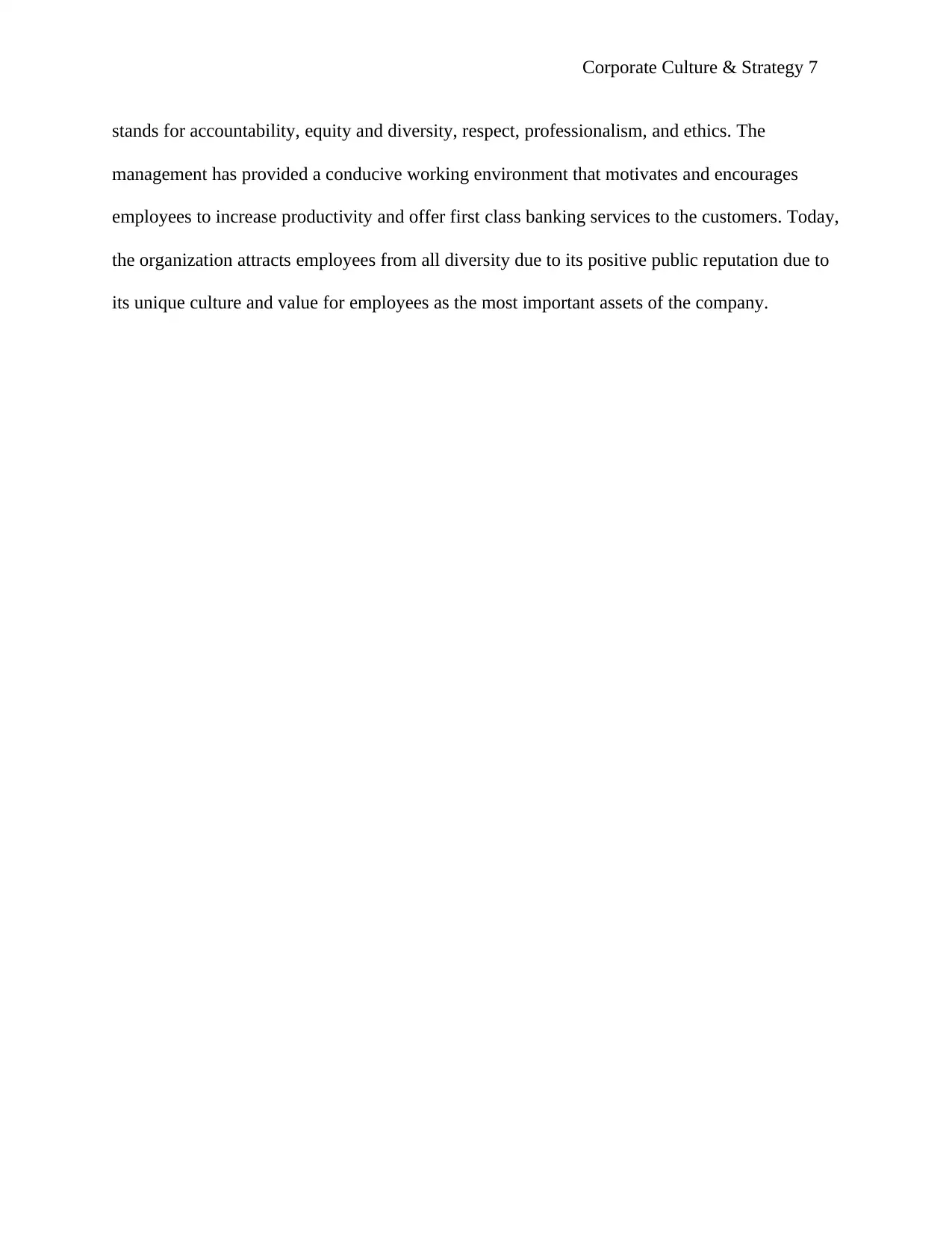
Corporate Culture & Strategy 7
stands for accountability, equity and diversity, respect, professionalism, and ethics. The
management has provided a conducive working environment that motivates and encourages
employees to increase productivity and offer first class banking services to the customers. Today,
the organization attracts employees from all diversity due to its positive public reputation due to
its unique culture and value for employees as the most important assets of the company.
stands for accountability, equity and diversity, respect, professionalism, and ethics. The
management has provided a conducive working environment that motivates and encourages
employees to increase productivity and offer first class banking services to the customers. Today,
the organization attracts employees from all diversity due to its positive public reputation due to
its unique culture and value for employees as the most important assets of the company.
Paraphrase This Document
Need a fresh take? Get an instant paraphrase of this document with our AI Paraphraser
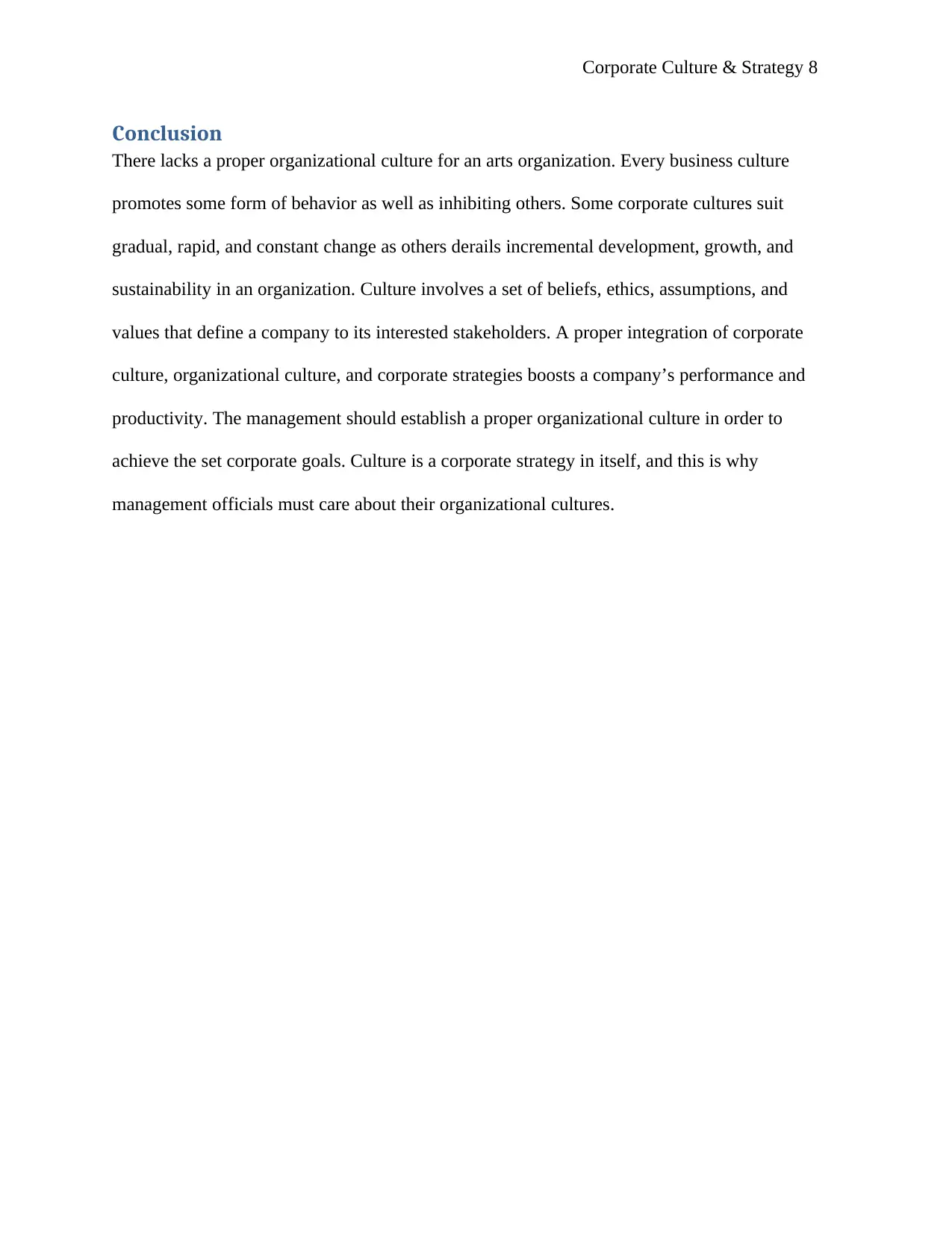
Corporate Culture & Strategy 8
Conclusion
There lacks a proper organizational culture for an arts organization. Every business culture
promotes some form of behavior as well as inhibiting others. Some corporate cultures suit
gradual, rapid, and constant change as others derails incremental development, growth, and
sustainability in an organization. Culture involves a set of beliefs, ethics, assumptions, and
values that define a company to its interested stakeholders. A proper integration of corporate
culture, organizational culture, and corporate strategies boosts a company’s performance and
productivity. The management should establish a proper organizational culture in order to
achieve the set corporate goals. Culture is a corporate strategy in itself, and this is why
management officials must care about their organizational cultures.
Conclusion
There lacks a proper organizational culture for an arts organization. Every business culture
promotes some form of behavior as well as inhibiting others. Some corporate cultures suit
gradual, rapid, and constant change as others derails incremental development, growth, and
sustainability in an organization. Culture involves a set of beliefs, ethics, assumptions, and
values that define a company to its interested stakeholders. A proper integration of corporate
culture, organizational culture, and corporate strategies boosts a company’s performance and
productivity. The management should establish a proper organizational culture in order to
achieve the set corporate goals. Culture is a corporate strategy in itself, and this is why
management officials must care about their organizational cultures.
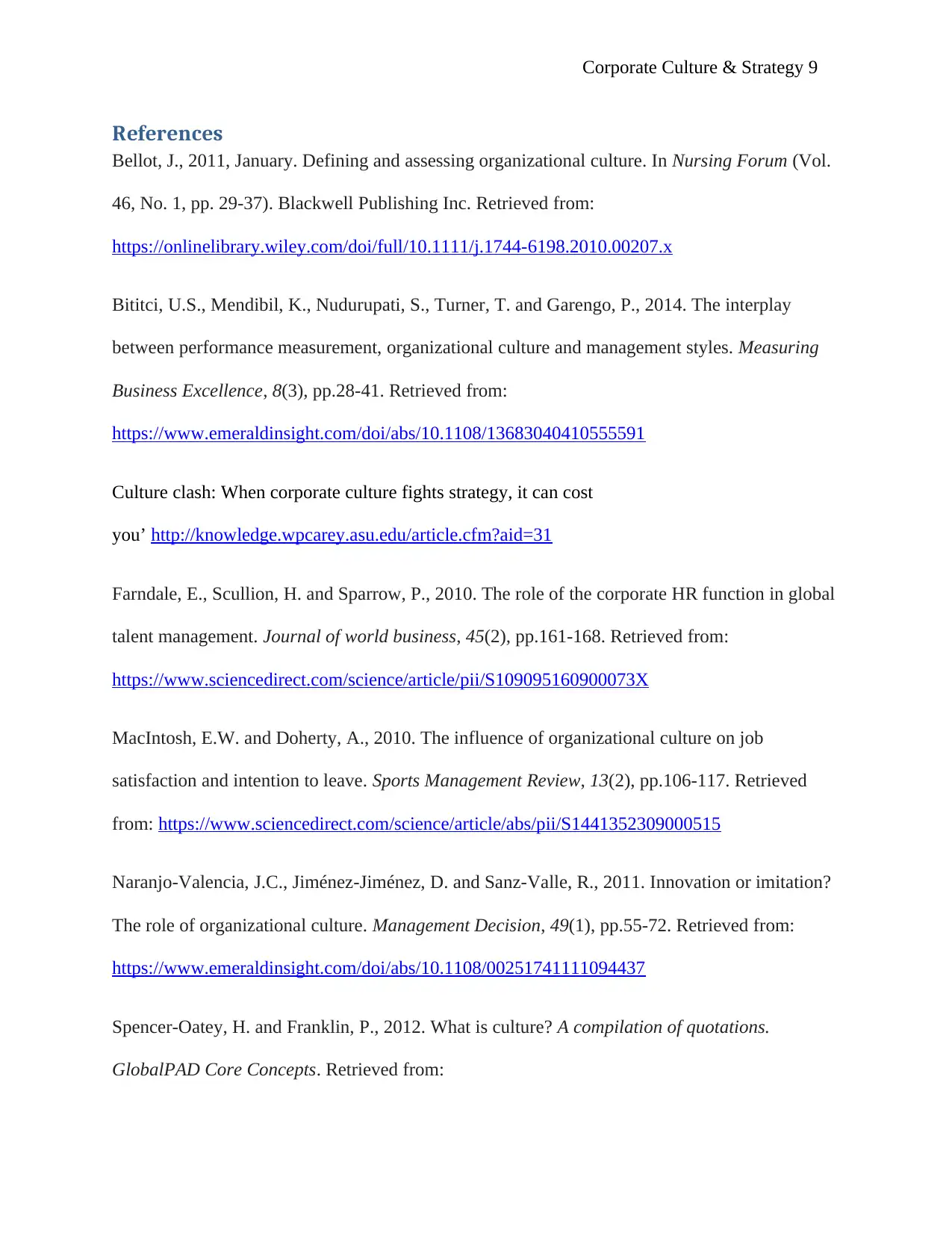
Corporate Culture & Strategy 9
References
Bellot, J., 2011, January. Defining and assessing organizational culture. In Nursing Forum (Vol.
46, No. 1, pp. 29-37). Blackwell Publishing Inc. Retrieved from:
https://onlinelibrary.wiley.com/doi/full/10.1111/j.1744-6198.2010.00207.x
Bititci, U.S., Mendibil, K., Nudurupati, S., Turner, T. and Garengo, P., 2014. The interplay
between performance measurement, organizational culture and management styles. Measuring
Business Excellence, 8(3), pp.28-41. Retrieved from:
https://www.emeraldinsight.com/doi/abs/10.1108/13683040410555591
Culture clash: When corporate culture fights strategy, it can cost
you’ http://knowledge.wpcarey.asu.edu/article.cfm?aid=31
Farndale, E., Scullion, H. and Sparrow, P., 2010. The role of the corporate HR function in global
talent management. Journal of world business, 45(2), pp.161-168. Retrieved from:
https://www.sciencedirect.com/science/article/pii/S109095160900073X
MacIntosh, E.W. and Doherty, A., 2010. The influence of organizational culture on job
satisfaction and intention to leave. Sports Management Review, 13(2), pp.106-117. Retrieved
from: https://www.sciencedirect.com/science/article/abs/pii/S1441352309000515
Naranjo-Valencia, J.C., Jiménez-Jiménez, D. and Sanz-Valle, R., 2011. Innovation or imitation?
The role of organizational culture. Management Decision, 49(1), pp.55-72. Retrieved from:
https://www.emeraldinsight.com/doi/abs/10.1108/00251741111094437
Spencer-Oatey, H. and Franklin, P., 2012. What is culture? A compilation of quotations.
GlobalPAD Core Concepts. Retrieved from:
References
Bellot, J., 2011, January. Defining and assessing organizational culture. In Nursing Forum (Vol.
46, No. 1, pp. 29-37). Blackwell Publishing Inc. Retrieved from:
https://onlinelibrary.wiley.com/doi/full/10.1111/j.1744-6198.2010.00207.x
Bititci, U.S., Mendibil, K., Nudurupati, S., Turner, T. and Garengo, P., 2014. The interplay
between performance measurement, organizational culture and management styles. Measuring
Business Excellence, 8(3), pp.28-41. Retrieved from:
https://www.emeraldinsight.com/doi/abs/10.1108/13683040410555591
Culture clash: When corporate culture fights strategy, it can cost
you’ http://knowledge.wpcarey.asu.edu/article.cfm?aid=31
Farndale, E., Scullion, H. and Sparrow, P., 2010. The role of the corporate HR function in global
talent management. Journal of world business, 45(2), pp.161-168. Retrieved from:
https://www.sciencedirect.com/science/article/pii/S109095160900073X
MacIntosh, E.W. and Doherty, A., 2010. The influence of organizational culture on job
satisfaction and intention to leave. Sports Management Review, 13(2), pp.106-117. Retrieved
from: https://www.sciencedirect.com/science/article/abs/pii/S1441352309000515
Naranjo-Valencia, J.C., Jiménez-Jiménez, D. and Sanz-Valle, R., 2011. Innovation or imitation?
The role of organizational culture. Management Decision, 49(1), pp.55-72. Retrieved from:
https://www.emeraldinsight.com/doi/abs/10.1108/00251741111094437
Spencer-Oatey, H. and Franklin, P., 2012. What is culture? A compilation of quotations.
GlobalPAD Core Concepts. Retrieved from:
⊘ This is a preview!⊘
Do you want full access?
Subscribe today to unlock all pages.

Trusted by 1+ million students worldwide
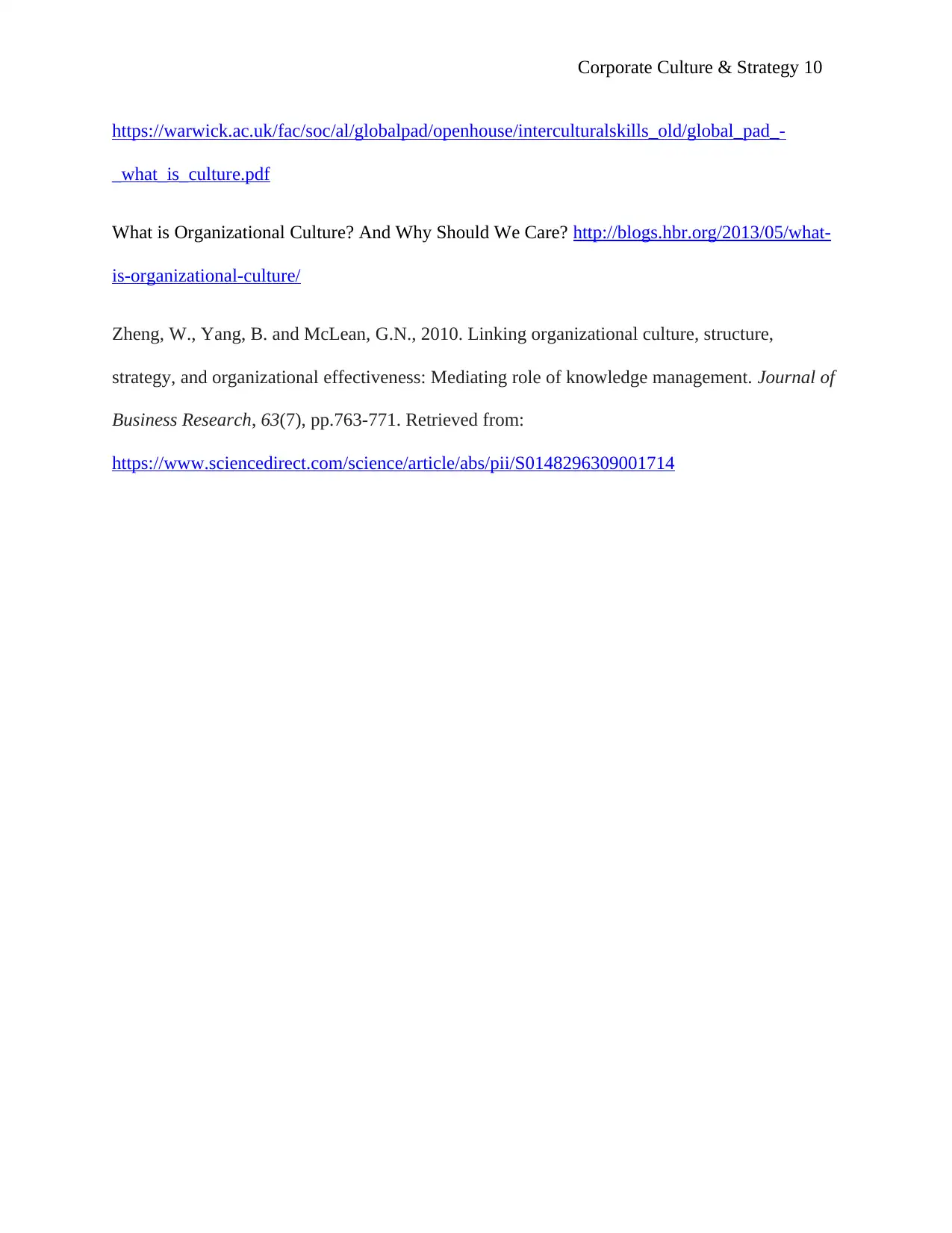
Corporate Culture & Strategy 10
https://warwick.ac.uk/fac/soc/al/globalpad/openhouse/interculturalskills_old/global_pad_-
_what_is_culture.pdf
What is Organizational Culture? And Why Should We Care? http://blogs.hbr.org/2013/05/what-
is-organizational-culture/
Zheng, W., Yang, B. and McLean, G.N., 2010. Linking organizational culture, structure,
strategy, and organizational effectiveness: Mediating role of knowledge management. Journal of
Business Research, 63(7), pp.763-771. Retrieved from:
https://www.sciencedirect.com/science/article/abs/pii/S0148296309001714
https://warwick.ac.uk/fac/soc/al/globalpad/openhouse/interculturalskills_old/global_pad_-
_what_is_culture.pdf
What is Organizational Culture? And Why Should We Care? http://blogs.hbr.org/2013/05/what-
is-organizational-culture/
Zheng, W., Yang, B. and McLean, G.N., 2010. Linking organizational culture, structure,
strategy, and organizational effectiveness: Mediating role of knowledge management. Journal of
Business Research, 63(7), pp.763-771. Retrieved from:
https://www.sciencedirect.com/science/article/abs/pii/S0148296309001714
1 out of 10
Related Documents
Your All-in-One AI-Powered Toolkit for Academic Success.
+13062052269
info@desklib.com
Available 24*7 on WhatsApp / Email
![[object Object]](/_next/static/media/star-bottom.7253800d.svg)
Unlock your academic potential
Copyright © 2020–2025 A2Z Services. All Rights Reserved. Developed and managed by ZUCOL.





